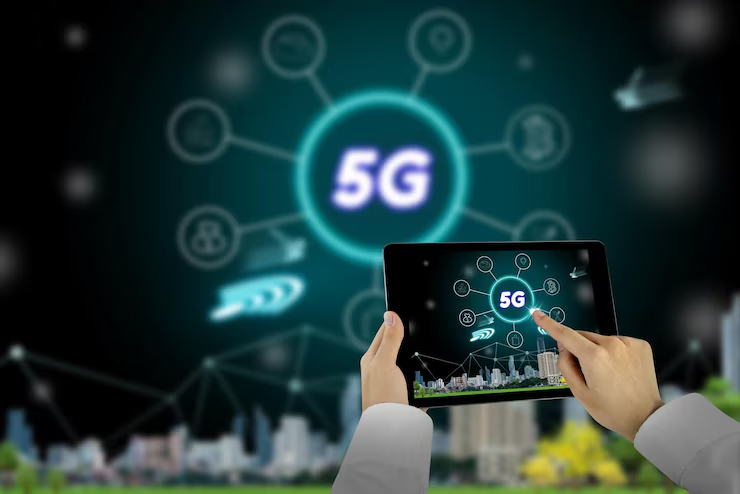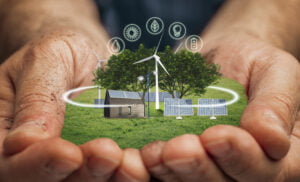The advent of 5G technology heralds a new era of connectivity, promising unprecedented speed, reliability, and connectivity for a wide array of applications.
Unlike its predecessors, 5G is not merely an incremental upgrade but represents a fundamental shift in telecommunications infrastructure, with the potential to revolutionize industries and redefine how we interact with technology.
However, amidst the excitement surrounding the rollout of 5G networks, it’s crucial to examine the impact of this technology on power consumption and management.
As 5G networks continue to proliferate, they bring with them significant challenges and opportunities in terms of energy consumption and sustainability.
Understanding the implications of 5G on power management is essential for optimizing network performance, minimizing environmental impact, and ensuring the long-term viability of this transformative technology.
In this discussion, we will delve into the intricacies of 5G technology, exploring its unique features, applications, and implications for power consumption.
We will examine the challenges posed by increased data transmission speeds and network densification, as well as the opportunities for implementing energy-efficient solutions.
Furthermore, we will explore the impact of 5G on end-user devices and the broader environmental considerations associated with its deployment.
Power Consumption Challenges in 5G Networks
The deployment of 5G networks presents a host of challenges in terms of power consumption, stemming from the increased data transmission speeds, network densification, and complex infrastructure requirements inherent in this next-generation technology.
Understanding and addressing these challenges is essential for optimizing the efficiency and sustainability of 5G networks.
A. Increased Data Transmission Speeds and Network Densification
One of the defining features of 5G technology is its ability to deliver significantly higher data transmission speeds compared to previous generations.
While this represents a major leap forward in terms of network performance, it also comes with increased power demands.
The need to support ultra-fast data rates requires network equipment to operate at higher frequencies and process larger volumes of data, resulting in elevated energy consumption.
Moreover, the densification of 5G networks, characterized by the deployment of a higher density of small cells and base stations, further exacerbates power consumption challenges.
As more infrastructure is deployed to support the growing demand for connectivity, the energy requirements of maintaining and operating these network elements increase proportionally.
This trend towards densification is driven by the need to enhance network coverage, capacity, and reliability, particularly in urban areas where demand for high-speed connectivity is greatest.
B. Energy Requirements of Small Cells, Base Stations, and Network Infrastructure
In addition to the increased energy demands associated with higher data transmission speeds and network densification, the deployment of 5G networks introduces new challenges in terms of the energy requirements of individual network components.
Small cells, which are essential for extending coverage and capacity in densely populated areas, consume significant amounts of power to operate effectively. Similarly, base stations, which serve as the backbone of 5G networks, require substantial energy inputs to transmit and receive data from connected devices.
Furthermore, the network infrastructure supporting 5G, including fiber optic cables, routers, switches, and other hardware components, also contributes to overall power consumption.
As the scale and complexity of 5G infrastructure continue to expand, so too do the energy requirements of maintaining and operating these critical assets.
C. Impact of Higher Frequencies and Signal Processing on Power Consumption
Another factor contributing to the power consumption challenges in 5G networks is the use of higher frequencies for data transmission.
Unlike previous generations of wireless technology, which primarily relied on lower frequency bands, 5G networks utilize millimeter wave (mmWave) frequencies to achieve faster data rates and lower latency.
While mmWave technology offers significant benefits in terms of network performance, it also requires more power to operate effectively.
Moreover, the signal processing algorithms and technologies employed in 5G networks, such as massive MIMO (Multiple Input, Multiple Output) and beamforming, further increase power consumption.
These advanced signal processing techniques enable more efficient use of available spectrum and improve network performance, but they also require additional computational resources and energy inputs.
Opportunities for Power Management in 5G Networks
While the deployment of 5G networks presents significant challenges in terms of power consumption, it also offers numerous opportunities for implementing effective power management strategies.
By leveraging innovative technologies and approaches, stakeholders can optimize the efficiency and sustainability of 5G networks while maximizing performance and reliability.
A. Optimizing Network Architecture for Energy Efficiency
One of the key opportunities for power management in 5G networks lies in optimizing network architecture to minimize energy consumption.
This involves designing network elements, such as small cells and base stations, with energy efficiency in mind.
For example, the use of advanced hardware components and power-saving features can help reduce the energy requirements of individual network elements without compromising performance.
Furthermore, optimizing the deployment and configuration of network infrastructure can also contribute to energy savings.
By strategically locating small cells and base stations and adjusting their transmission power levels based on network demand, operators can minimize unnecessary energy consumption while ensuring adequate coverage and capacity.
B. Implementing Intelligent Power Management Algorithms and Technologies
Another opportunity for power management in 5G networks lies in the implementation of intelligent power management algorithms and technologies.
Machine learning and artificial intelligence can be used to analyze network data in real time and dynamically adjust power usage based on changing network conditions.
For example, algorithms can optimize the allocation of resources, such as frequency bands and transmission power levels, to minimize energy consumption while maintaining the quality of service.
Additionally, the use of energy-efficient hardware components and power-saving features can further enhance power management in 5G networks.
For example, the adoption of low-power integrated circuits, energy-efficient antennas, and power amplifiers can help reduce the overall energy footprint of network infrastructure.
C. Leveraging Renewable Energy Sources for Powering 5G Infrastructure
A promising opportunity for power management in 5G networks is the integration of renewable energy sources, such as solar and wind power, into network infrastructure.
By harnessing renewable energy to power small cells, base stations, and other network elements, operators can reduce reliance on traditional energy sources and minimize carbon emissions.
Furthermore, the use of energy storage systems, such as batteries and supercapacitors, can help store excess energy generated by renewable sources and provide backup power during periods of low renewable energy production. This can enhance the resilience and reliability of 5G networks while reducing their environmental impact.
D. Integration of Energy-Saving Components and Materials in Network Equipment
Additionally, the integration of energy-saving components and materials in network equipment presents an opportunity for reducing power consumption in 5G networks.
For example, the use of energy-efficient cooling systems, such as liquid cooling and passive cooling technologies, can help minimize energy consumption associated with thermal management.
Furthermore, the adoption of energy-efficient hardware components, such as low-power processors and energy-saving antennas, can help reduce the overall energy footprint of network infrastructure.
By prioritizing the use of energy-saving technologies and materials in the design and manufacturing of network equipment, stakeholders can significantly improve the energy efficiency of 5G networks.
Impact on End-User Devices and Power Consumption
The widespread adoption of 5G technology not only impacts network infrastructure but also significantly influences the power consumption of end-user devices.
As consumers increasingly rely on smartphones, tablets, IoT devices, and other connected gadgets to access 5G networks, understanding the implications for power consumption is essential for optimizing device performance and battery life.
A. Evolution of Smartphones and Connected Devices to Support 5G
One of the most immediate impacts of 5G technology on end-user devices is the evolution of smartphones and other connected gadgets to support higher data transmission speeds and network capabilities.
Manufacturers are continuously developing and releasing 5G-enabled devices equipped with advanced hardware components, such as 5G modems, antennas, and processors, to capitalize on the benefits of the new technology.
However, the integration of 5G capabilities into end-user devices comes with implications for power consumption.
The increased processing power and energy requirements of 5G modems and antennas can result in higher power consumption compared to previous generations of wireless technology.
Additionally, the faster data transmission speeds and lower latency of 5G networks may lead to more frequent and intensive use of connected devices, further impacting battery life and power consumption.
B. Battery Life Considerations and Challenges in 5G-Enabled Devices
One of the primary concerns for consumers and manufacturers alike is the impact of 5G technology on battery life.
The increased power demands of 5G modems, antennas, and other hardware components can place additional strain on device batteries, reducing overall battery life and necessitating more frequent recharging.
Furthermore, the transition to 5G networks may require manufacturers to develop new battery technologies capable of supporting the higher energy requirements of connected devices.
This includes advancements in battery capacity, efficiency, and charging speed to accommodate the demands of 5G technology without sacrificing user experience.
Addressing battery life considerations and challenges in 5G-enabled devices requires a multi-faceted approach that involves optimizing hardware design, software algorithms, and power management features.
Manufacturers must balance the need for performance and connectivity with the desire for longer battery life, ensuring that end-users can fully leverage the benefits of 5G technology without compromising on device usability.
C. Strategies for Mitigating Power Drain in Consumer Electronics
To mitigate the impact of 5G technology on power consumption in end-user devices, manufacturers can implement various strategies aimed at optimizing energy efficiency and extending battery life.
This includes the development of power-saving features, such as adaptive brightness controls, background app management, and low-power modes, that help minimize energy consumption during periods of inactivity or low network usage.
Additionally, advancements in semiconductor technology, such as more efficient processors and memory modules, can help reduce the overall power footprint of end-user devices without sacrificing performance.
By leveraging hardware and software optimizations, manufacturers can enhance the energy efficiency of 5G-enabled devices and provide users with a seamless and reliable experience.
Environmental Implications and Sustainability Considerations
As 5G technology continues to proliferate, it brings with it a range of environmental implications and sustainability considerations that must be carefully addressed.
While 5G offers tremendous potential for innovation and economic growth, its deployment and operation can also have significant environmental impacts, including energy consumption, electronic waste generation, and resource depletion.
A. Carbon Footprint of 5G Networks Compared to Previous Generations
One of the primary environmental concerns associated with 5G technology is its carbon footprint compared to previous generations of wireless technology.
The increased energy demands of 5G networks, driven by higher data transmission speeds, network densification, and complex infrastructure requirements, can result in greater greenhouse gas emissions and environmental degradation.
Furthermore, the transition to 5G networks may necessitate the expansion of network infrastructure, including the installation of additional small cells, base stations, and fiber optic cables, which can further contribute to carbon emissions.
It is essential to assess the environmental impact of 5G deployment and identify strategies for minimizing carbon emissions and promoting sustainability.
B. Potential Environmental Benefits and Challenges Associated with 5G Deployment
While 5G technology presents environmental challenges, it also offers potential benefits in terms of sustainability and resource efficiency.
For example, the increased efficiency and capacity of 5G networks can enable more sustainable practices in various sectors, such as transportation, manufacturing, and energy, by optimizing resource allocation, reducing waste, and promoting renewable energy adoption.
However, realizing these potential benefits requires careful planning and coordination to ensure that 5G deployment aligns with sustainability goals and objectives.
This includes integrating environmental considerations into network design and planning processes, prioritizing energy-efficient technologies and practices, and fostering collaboration between stakeholders to address environmental challenges effectively.
C. Role of Regulatory Bodies and Industry Standards in Promoting Energy-Efficient Practices
Regulatory bodies and industry standards play a crucial role in promoting energy-efficient practices and sustainability in the deployment and operation of 5G networks.
Governments and regulatory agencies can establish policies, incentives, and regulations that encourage the adoption of renewable energy sources, energy-efficient technologies, and sustainable practices in 5G deployment.
Similarly, industry associations and standards organizations can develop guidelines, best practices, and certification programs that promote environmental sustainability and responsible resource management in 5G networks.
By setting clear standards and expectations for environmental performance, these organizations can help drive innovation and adoption of sustainable practices across the telecommunications industry.
Conclusion
The deployment of 5G technology represents a monumental shift in telecommunications infrastructure, offering unprecedented speed, reliability, and connectivity for a wide range of applications.
However, as 5G networks continue to proliferate, it is essential to consider the environmental implications and sustainability considerations associated with this transformative technology.
From energy consumption and carbon emissions to electronic waste generation and resource depletion, the environmental impact of 5G deployment must be carefully assessed and mitigated through strategic planning and collaboration.
While 5G technology presents significant environmental challenges, it also offers opportunities for promoting sustainability and resource efficiency.
By leveraging renewable energy sources, optimizing network architecture, and implementing energy-efficient technologies and practices, stakeholders can minimize the carbon footprint of 5G networks and contribute to a more sustainable future.
Additionally, regulatory bodies and industry standards play a crucial role in driving innovation and adoption of sustainable practices in 5G deployment, ensuring that environmental considerations are prioritized alongside technological advancements.
In conclusion, the transition to 5G technology represents a pivotal moment in the evolution of telecommunications, with far-reaching implications for society, the economy, and the environment.
By addressing environmental concerns and promoting sustainability in 5G deployment, we can harness the full potential of this transformative technology while minimizing its environmental impact and creating a more resilient and sustainable future for generations to come.












